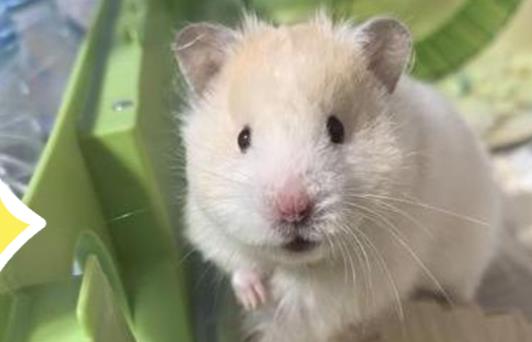Under certain circumstances, hamsters may indeed eat their own offspring. This behavior is mostly related to survival instincts, environmental stress, or the health of the pups, rather than malice. Below are the specific reasons and preventive measures:

1. Common Reasons Why Hamsters Eat Their Young
Weak or Deceased Pups
Hamsters judge the health of their pups through their sense of smell. If a pup is weak, deformed, or already deceased at birth, the mother hamster will eat it to avoid attracting predators and to recycle nutrients to replenish her own energy.
Example: If a pup fails to suckle milk in time after birth, has a low body temperature, or is injured by the mother’s accidental stepping, it may be deemed an "unviable offspring" and disposed of.
Environmental Disturbance or Stress
Frequent Checking: Excessive human observation or touching of the pups can leave strange scents on them, causing the mother hamster to abandon or even eat the pups out of anxiety.
Noise/Vibration: Loud noises or vibrations near the cage (such as tapping the cage or placing it next to a TV) can trigger a stress response in the mother hamster.
Inadequate Space: A cage that is too small (a basic cage size of at least 40cm × 30cm is recommended) or lacks hiding spots (such as a cotton nest or cardboard box) can make the mother hamster feel insecure, leading her to attack the pups.
Nutritional Deficiency
Mother hamsters require large amounts of protein and energy during lactation. If their diet lacks protein (e.g., being fed only grains), the water is contaminated, or supplementary foods like mealworms or boiled egg whites are not provided, the mother hamster may eat her pups due to hunger or nutritional imbalance.
First-Time Mothers or Elderly Mothers
First-Time Mothers: Young mother hamsters (4-6 months old) may accidentally harm their pups due to inexperience and anxiety.
Elderly Mothers: Mother hamsters over 1 year old have declining reproductive ability, resulting in lower pup survival rates, and they are more likely to exhibit pup-eating behavior.
Disturbance from Male Hamsters
If the male hamster is not separated in time after the mother gives birth, he may attack the pups to compete for territory or mistake them for "rivals." In some cases, the mother hamster may even eat her pups to protect them from the male.
2. Measures to Prevent Hamsters from Eating Their Young
Provide a Safe and Concealed Birthing Den
Den Selection: Use a ceramic nest, cardboard box, or specialized birthing den (with a small door) as the mother’s nest. Line the interior with dust-free wood shavings or paper cotton to keep it dark and quiet.
Avoid Disturbance: Do not move the cage, change the bedding, or check the pups frequently within 1 week after birth. A camera can be used to monitor the pups remotely.
Ensure Adequate Nutrition
Staple Food: Offer high-protein hamster food (e.g., mixed food containing sunflower seeds and alfalfa), avoiding a diet of only grains.
Supplementary Food: Feed 1-2 mealworms, a small amount of boiled egg white, or unsweetened yogurt daily to supplement protein and calcium.
Water: Provide clean, cool boiled water using a ball-point water bottle, and replace it daily.
Separate the Male Hamster in Time
After the mother hamster becomes pregnant, move the male hamster to another cage to prevent him from approaching the pups after birth. Do not return the male hamster to the mother’s cage until the pups are weaned (around 21 days old) to avoid inbreeding or fights.
Reduce Stress Factors
Environment: Place the cage in a quiet corner, away from damp areas like kitchens and bathrooms, and avoid direct sunlight.
Handling: When changing bedding or adding food, move gently to avoid suddenly startling the mother hamster.
Observe the Mother Hamster’s Behavior
Normal Behavior: The mother hamster will frequently enter and exit the birthing den, gather the pups together, lick and clean them, and actively feed them.
Abnormal Signs: If the mother hamster stays away from the den for a long time, the pups have bloodstains on their bodies, or are dragged out of the den, immediate intervention is needed (e.g., wear gloves to move the pups to a warm small container, wipe them with the mother’s bedding to retain her scent, then return them to the den).
3. Handling Special Situations
The Mother Hamster Has Eaten Some Pups
Immediately remove the remaining pups, wrap them in a warm towel to simulate the mother’s body temperature, and feed them diluted goat milk (slowly dripped in using a syringe). If you have no experience in raising young hamsters, contact a pet hospital or hamster rescue organization for help.
The Mother Hamster Abandons Her Pups
Try wiping the pups with the mother’s urine or playing a recording of the mother’s sounds to stimulate her maternal instinct. If this is ineffective, artificial feeding is required (feed goat milk every 2 hours for 3 weeks).
The Male Hamster Participates in Raising Pups
In rare cases, male hamsters (such as those of the Campbells dwarf hamster species) may help care for the pups. However, close observation is still necessary to prevent fights.
